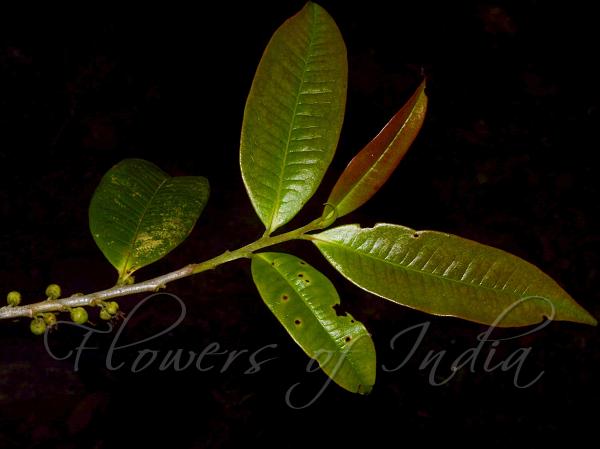|
| Cherry-Leaf Eurya |
|

|

| File size | 419264 |
| Original date | 5/16/18 3:17 PM |
| Resolution | 3008 x 2000 |
| Flash | Flash fired, return detected |
| Focal length | 60.0mm |
| Exposure time | 1/200s |
| Aperture | 29.0 |
| Focus Distance | |
| Metering Mode | Multi-segment |
| Camera make | NIKON CORPORATION |
| Camera model | NIKON D3200 |
| Sensor type | OneChipColorArea |
|
|
|
|
Photo: |
Botanical name: Eurya cerasifolia Family: Theaceae (Tea family)
Synonyms: Diospyros cerasifolia, Diospyros feminina, Eurya wallichiana
Synonyms: Diospyros cerasifolia, Diospyros feminina, Eurya wallichiana
Cherry-Leaf Eurya is a shrub or small tree, 2-7 m
tall; stems greyish-brown, striped, sparsely sctose; branchlets and
apical buds adpressed velvet-hairy, ultimately hairless. Leaves are
4-12 x 2-4.5 cm, broadly elliptic, elliptic-lanceshaped or
ovate-oblong, pointed to wedge-shaped at base, bluntly tapering at tip,
entire or sawtoothed towards tip, papery, dark green with blotches and
hairless above, midrib velvet-hairy beneath, lateral veins 20 or more
on each half, distinct on both surfaces; leaf-stalks 2-6 mm long,
velvet-hairy. Flowers are white or yellowish-white, 4-5 in in
leaf-axils fascicles; flower-stalks 2-4 mm long. Sepals are 2-3.5 x
2-2.5 mm, broadly elliptic blunt, velvet-hairy outside. Petals are
4.5-5 x 2.5-3 mm, oblong-elliptic, blunt, fused at base, hairless.
Stamens are 15-17, unequal, filaments 1-3 mm long, fused at base,
hairless, anthers 1-2.5 mm long. Berries are 5-7 x 4-4.5 mm, ellipsoid
or almost spherical, dark brown or blue black. Cherry-Leaf Eurya is
found in subtropical and temperate forests at 1500-2200 m altitudes, in
West Bengal, Sikkim, Assam, Arunachal Pradesh, Nagaland, Manipur and
Meghalaya. It is also found in Nepal, Bhutan, Myanmar and China.
Flowering: October-June.
| Identification credit: Tapas Chakrabarty | Photographed at Sakiyong Khasmahal, Pedong Reshi Rd, India. |
• Is this flower misidentified? If yes,